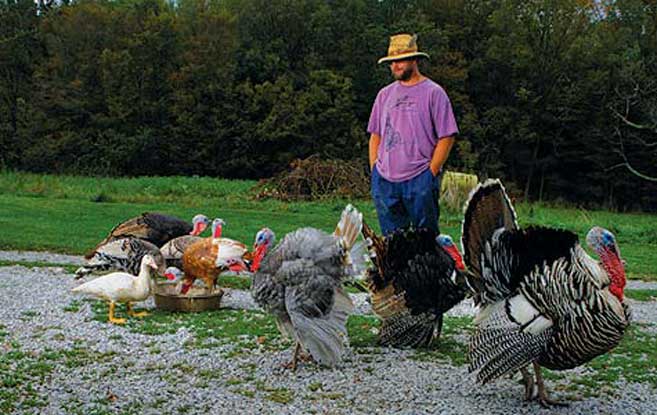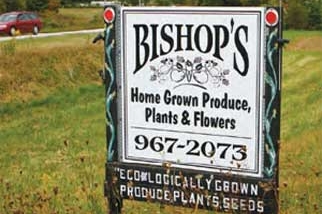Building A Better Turkey
Bishop’s Homegrown crosses wild and domestic with tasty results
Driving Route 60 north through the rolling farmland of Southern Indiana, a friend and I pass sprawling front lawns planted in closely mown grass, aisles of identical ornamental trees and fields of uniform corn rows. We turn off onto a rough gravel road that curves alongside railroad tracks before crossing them to wind uphill, past plots of squash, beans, melons, tomatoes and corn. A motley flock of variegated, gabbling, screeching poultry of all sizes, shapes and colors trumpets our arrival as we pull up in the sloping driveway of the farmhouse.
This is the domain of Alan Bishop, owner of Bishop’s Homegrown and Face of the Earth Seed, and it is a world away from the rural community that surrounds him. Instead of lawns and field corn, food grows on Bishop’s farm. He grows for a farmers’ market, and for a modified food subscription service. As we emerge from the car, Bishop starts talking turkey.
Heritage turkey, that is. Or, more accurately, landraces, which result from crossing domesticated plant or animal varieties with wild specimens to create genetic diversity and improve adaptation to the specific locale, like plants that thrive on less water in drought-prone areas, or turkeys that grow well in a particular region.
The farm in Pekin (home to the “nation’s oldest consecutive Fourth of July celebration”) has been in the Bishop family for four generations. His grandparents grew tobacco on the 40-acre spread, and Bishop learned the tobacco trade growing up. As a high school student he took agriculture-related classes and even entertained studying agriculture at Purdue University. He had no particular interest in continuing the family business the way he had learned it, however. He wasn’t interested in chemical fertilizers and pesticides. Bishop recalls feeling even as a young boy that there was a better way, a way more in harmony with the natural order of things.
Instead of going to college, he pursued a music career, traveling with a band and working landscape jobs on the side. But in 2004 he was drawn back home, which had not been a productive farm since 1998. “[My grandmother] encouraged me to take up the reins and do something here full time,” he says. He built greenhouses with money he’d saved, and with help from his parents. He grew peppers and tomatoes, experimenting with plant breeding, growing food and selling it at farmers’ markets. “All of my life, local and homegrown food had just been something that was always available to me,” he says. His time away from the farm helped him understand the value of local food.
So he began to research sustainable agriculture, organic growing practices and plant and animal genetics, and began working toward a completely sustainable farm. “Everything I do is about completing cycles,” he says. Most of the grain that the turkeys eat grows right alongside them on the farm, but they also eat bugs and copious worms that thrive in the soil he’s amended over the years.
September 11, 2001, he says, was a pivotal moment, affecting how he thought about food and the food system. He became more intent about finding crops and livestock that grew well in his particular microclimate.
That’s where the landraces come in: breeding domestic species with hardier ones adapted to the climate and habitat here. His experiments run to all types of plants and poultry, not just turkeys.
Based on his research into turkey breeds, he is trying to develop a bird that is easy to raise without much intervention. He crossed a number of domestic turkeys with multiple wild varieties, selecting for traits such as high meat-to-bone ratio, leanness with a good proportion of body fat (for flavor), excellent survival and flight skills, the ability to evade predators and a good mothering instinct — traits that ultimately resulted in a better bird. Batman, an imposing specimen, is a Naragansett selected for his quick growth rate and high fertility ratio as well as his general size and carriage.
Bishop learned to process all his own birds watching YouTube videos, though he says that next year’s flock will be too large to process on his own. (As we stand chatting by the poultry pens, a crowd of pre-adolescent ducklings piles out of the coop, like clowns exiting a Volkswagen. They are watched closely by their foster mom, a handsome blue slate turkey. “She hatched out those little ducks,” says Alan.)
And as for taste — well, no one who has tasted his turkeys has any complaints. There’s no comparison between a commercial bird and one of Alan’s heritage turkeys, according to Kimberly Ratts, Alan’s fiancé and farming partner. “It’s a whole different classification of meat. It’s very rich,” she testifies. “I wouldn’t have any other kind of bird.” And it cooks differently. “I put one of our birds in the oven with a foil tent. Salt, pepper, some butter under the skin, and it came out perfectly brown, perfectly juicy. Whereas with a commercial bird, you’re either undercooking it and it looks white, or you’re overcooking it and drying it out to make it brown.”
Bishop and Ratts have sold all their turkeys for Thanksgiving, but will raise another round to be ready in the summer. The leaner birds, with their abundance of highly flavorful dark meat, will be perfect for grilling or spit-roasting.
Bishop encourages his customers to visit the farm and learn how their food is grown. “Food security begins when a relationship is formed between the community and its farmers,” his website says (address below). Interested in the past and concerned for the future, Bishop’s operation is a bridge between the two. He would like to see a local foodshed develop, where food is consumed close to where it’s produced. And he is interested in collaborating with other growers to form a bioregional seed company. He and Ratts continue their animal- and plant-breeding projects, hoping to stabilize their varieties and focus more on production.
Bishop lost turkeys to predators this year, and only has about 50 birds available for sale at the holidays. Customers who had hoped to score one for Thanksgiving will have to wait at least until summer, or next holiday season. The good news is that a heritage turkey raised on Alan Bishop’s farm is worth waiting for.
Bishop’s Homegrown and Face of the Earth Seed
Although his turkeys will most likely be sold out, Bishop will have the following items available through Thanksgiving: kale, collards, turnip greens, winter squash, sweet potatoes and his own landrace varieties of flower and vegetable seeds.
5604 S. State Rd. 60; Pekin IN 47165
Phone: 812-967-2073
homegrowngoodness.blogspot.com





